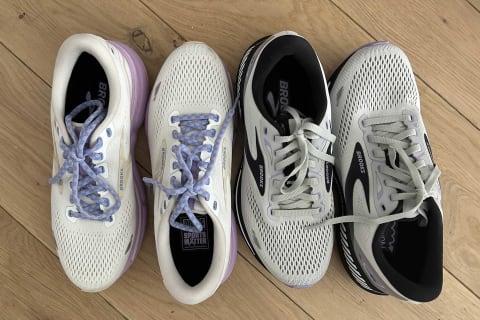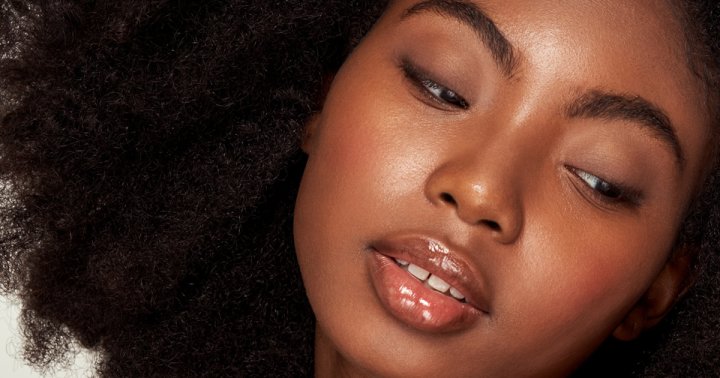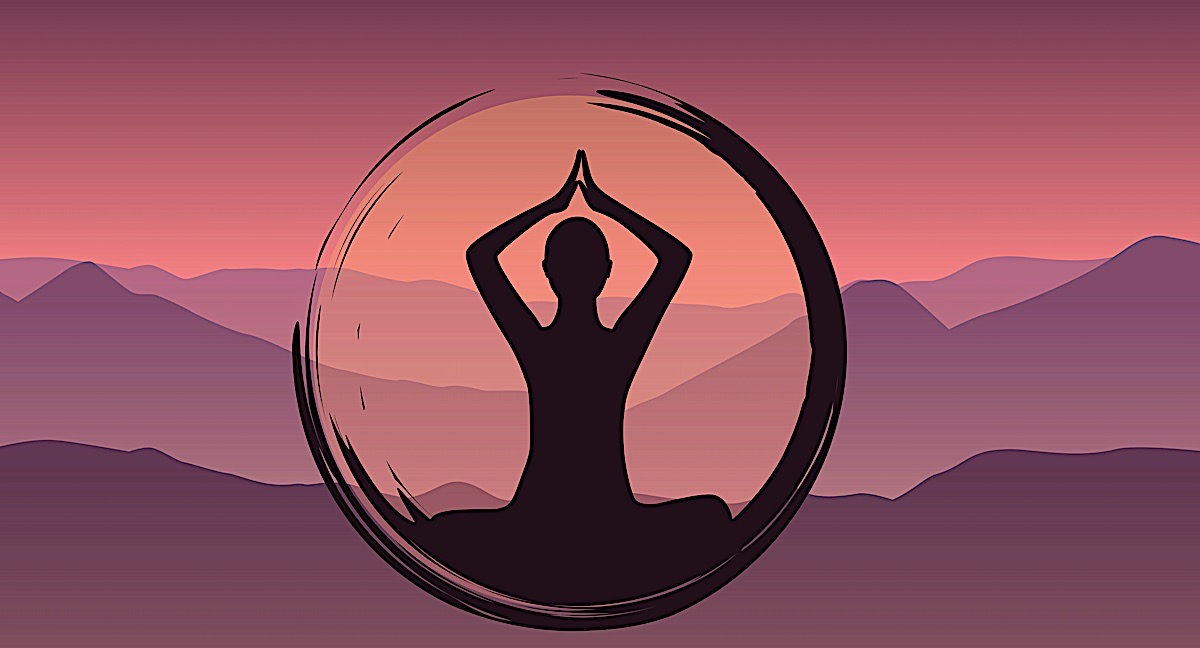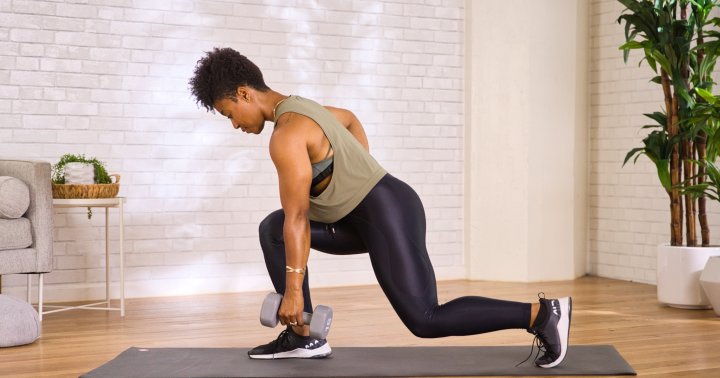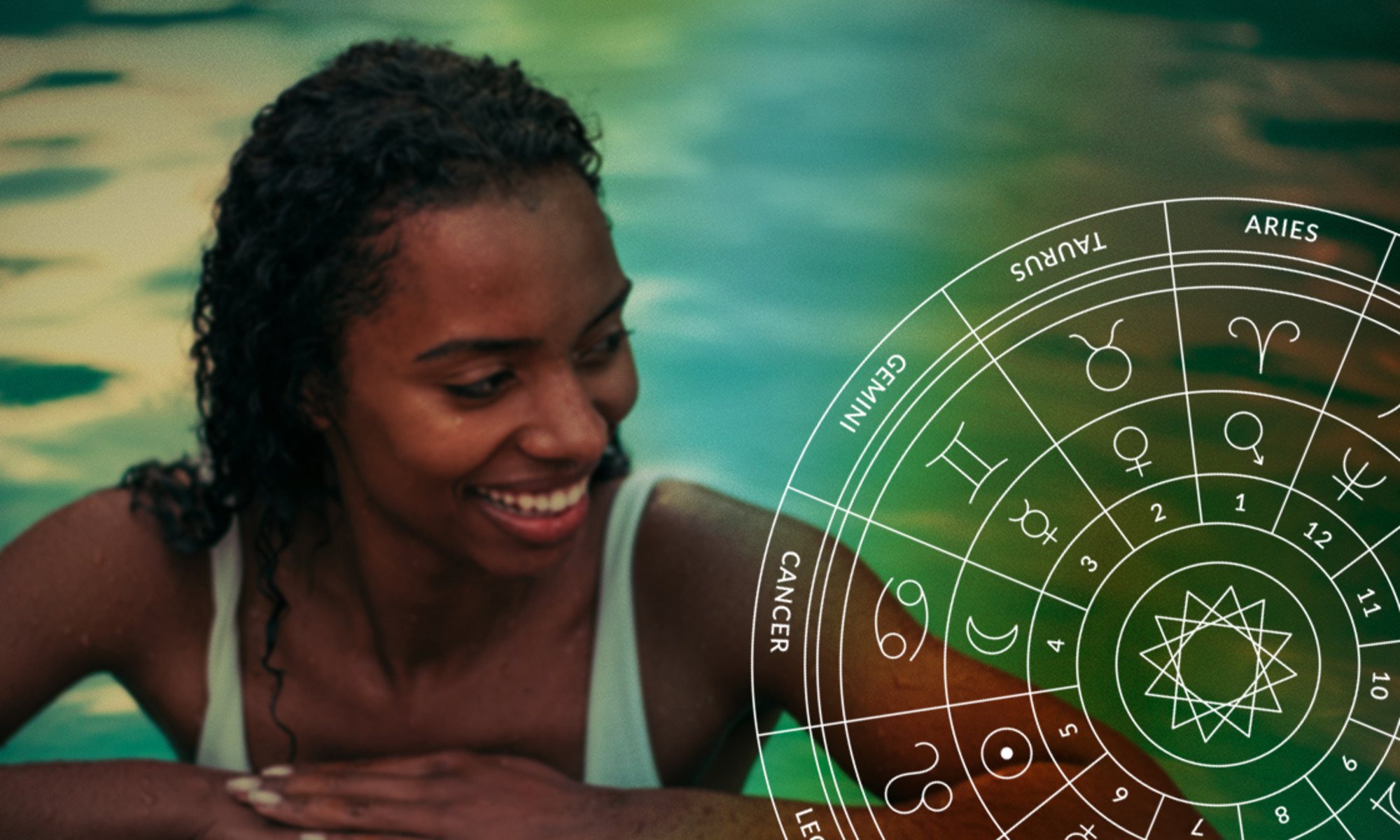Let's Settle It: Hoka Or Brooks? What Podiatrists & A Marathon Runner Say
Plus, how to choose.

Image by Carleigh Ferrante / mbg creative October 11, 2024 We carefully vet all products and services featured on mindbodygreen using our Our selections are never influenced by the commissions earned from our links. About 10 years ago, I ran my first 10K race, and I quickly fell in love with the sport. Since then, I’ve completed over a dozen half marathons, four world major marathons, and countless 5K races. This, combined with the fact that I write about fitness products for a living, means I’ve tested a lot of running sneakers. While there’s no shortage of options for runners to choose from, there are two that I get asked about constantly: Hoka vs. Brooks. Each has developed a cult following for its ability to cater to a wide variety of running styles and needs—but they’re actually quite different. Let’s dive into everything you need to know about Hoka vs. Brooks, based on months of extensive testing and insights from podiatrists. Plus, my favorite styles from each brand and who should try them. About the tester
My testing process
It doesn’t take much routine tweaking to test out a new pair of running shoes. When I’m not training for a marathon, I tend to run three to four times each week, covering anywhere between three and seven miles per run.
To fairly compare Brooks and Hoka, I dedicated at least six weeks to running exclusively in each style I tested. During these testing periods, I made sure to run on a variety of surfaces (road, treadmill, track, and trail) for a wide range of distances and workouts (sprints, easy runs, and long runs).
What is Brooks?
Brooks is a Seattle-based sportswear company making high-performance sneakers, clothing, and accessories. The brand’s designs are known for their cloud-like comfort, stability, and support, with a number of styles to choose from.
Aside from the immense cushioning, one thing that stands out about Brooks is the GuideRails technology, which the brand uses in its designs to help stabilize the foot and improve alignment between the knee and ankle for reduced risk of injury.
A few designs have the APMA Seal of Acceptance (indicating that the shoes promote good foot health), and podiatrists have recommended the Brooks designs to mindbodygreen for running, walking, and everyday wear.
"Brooks focuses on biomechanics and offers shoes with excellent support and stability, particularly beneficial for those with overpronation or other gait issues," says podiatrist Dina Gohil, DPM.
My experience testing Brooks
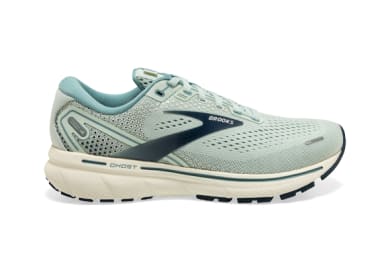

Image by Carleigh Ferrante / mbg creative
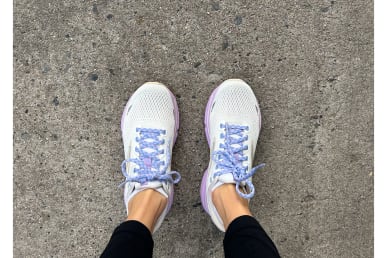
Image by Carleigh Ferrante / mbg creative
Ghost 16 by Brooks
Brooks Ghost 16
Sizes
5-13 (half, narrow, wide, & extra wide)
Pros & Cons
Cons
Cushioning in the forefront is a bit light
The Ghost 16 was my first foray into testing Brooks sneakers myself, but podiatrists have been praising them for years.
Sharkey previously told me the Ghost 16 is specifically great for those with high arches or wide feet, and podiatrist and founder of Dr. Brenner's RX, Hillary Brenner, DPM, added that they're among her top-recommended shoes for runners seeking a neutral shoe.
I spent six weeks testing the Brooks Ghost 16—and I was shocked by how supported I felt by these cloud-like, floaty sneakers. I wore them after a bit of an extended break from running, and they made what would have been a tough run feel surprisingly easy.
Over the course of six weeks, these shoes kept my feet supported and comfortable during more than 25 outdoor and indoor runs. They even passed my 10-mile run test straight out of the box without any break-in required.
Another perk? The Brooks Ghost 16 is made with 67.3% recycled materials in the upper and is certified Carbon Neutral.
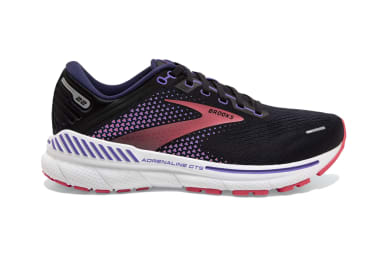
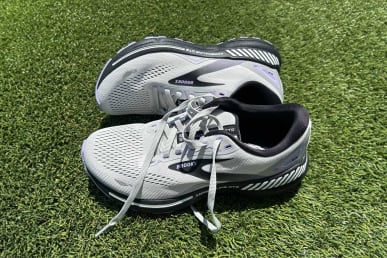
Image by Carleigh Ferrante / mbg creative

Image by Carleigh Ferrante / mbg creative
Adrenaline GTS 23 by Brooks
Brooks Adrenaline GTS 23
Pros & Cons
Pros
Exceptional stability and support
60% recycled materials in the upper
Great for all experience levels
Soft, comfortable cushioning
Cons
Some testers say they require a break-in period
On its 23rd iteration, the Brooks Adrenaline has been around for longer than the Ghost. In fact, the Ghost was actually initially marketed as a "more neutral version of the Adrenaline."
What first led me to the Adrenaline was a bout of knee pain a few years back. Many of my runner friends with sensitive knees agree that the Adrenalines are a standout pick—and podiatrist Anne Sharkey, DPM, Adrenaline recommended the Adrenaline sneakers for runners with knee pain or flat feet.
The Adrenaline is a stability shoe first and foremost. It’s designed to give guidance and support for runners who overpronate (which can lead to knee pain when you don’t have the right shoes).
While I (thankfully) don’t experience knee pain anymore, I was impressed by how comfortable and supportive these shoes are. The brand’s Guiderails technology really does keep your stride smooth over long or short distances.
What is Hoka?
Instantly recognizable by its rocker-style, max-cushioning design, Hoka was founded in 2009 by two avid runners (Jean-Luc Diard and Nicolas Mermoud). Their goal was to create a shoe with enhanced cushioning and support for runners tackling longer distances—and I’d say they delivered.
In my years of testing and writing about running shoes, plenty of podiatrists and running experts have recommended Hoka for better shock absorption and reduced impact on the joints. Many of the brand’s designs have also earned the podiatric APMA Seal of Acceptance, indicating the shoes promote good foot health.
Tim Dutra, DPM, M.S., MHCA, previously told mindbodygreen, "Hoka offers a variety of shoes with a wide range of cushioning and support and width options, and Hoka shoes are a favorite of runners, walkers, and hikers."
My experience testing Hoka
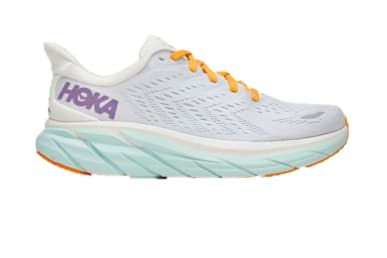
Hoka Clifton 9
Hoka Clifton 9
Sizes
5-12, half sizes available, wide sizes available
Pros & Cons
Pros
Plush padding around the collar and heel is very comfortable
Feel incredibly lightweight on your feet
Rocker design propels your foot forward
Cons
Exclusively for running (not great for gym workouts)
The Clifton 9 shoes have neutral stability, meaning they provide support but do not have the additional prescriptive technologies you’d want if you overpronate. While I do see many people wearing them at the gym, after extensive testing, I think they’re best for running or walking.
The Cliftons have a breathable, engineered knit upper with a gusseted tongue, a compression molded responsive EVA foam midsole, and a durable rubber outsole. The heel-to-toe drop is just 5 millimeters, which is on the low side compared to most running shoes I’ve tested.
Holistic podiatrist Robert Kornfeld, DPM, previously told mindbodygreen that the Clifton 9 is a great pick if walking and standing tend to put stress on your feet. “Its midfoot rocker bottom eases stress on the achilles as well as eases weight-bearing load in the forefoot.
Best for: runners who need stability, people with joint pain, distance running, walking

Image by Hoka / Hoka
Hoka Bondi 8
Hoka Bondi 8
Sizes
5-11, half sizes available
Pros & Cons
Pros
Most cushioned shoe on our list
Still surprisingly lightweight
Hoka’s most-cushioned shoe, the Bondi is truly one of the best maximalist running shoes you can find. It has significant bounce, with a tall stack height that goes from the heel to the toe.
They’re stable enough to keep the foot from over or underpronating, yet have enough cushioning to absorb the impact of your stride. When running in the Hoka Bondi 8, I like knowing I’m protecting my joints from harsh impact—and I can genuinely feel the shoes propelling me forward with every step.
Podiatrist Hillary Brenner, DPM, recommended these for distance runners, and Sharkey previously told mindbodygreen she likes the Bondi sneakers for treadmill runs, thanks to their significant shock absorption.
The Bondi has the lowest heel-to-toe drop on our list, at just 4mm—but it's also the heaviest, weighing in at 10.8 oz.
Best for: treadmill running, people who prefer the rocker design, people prone to knee pain, long distance runners
Comparing Brooks vs Hoka
Brooks vs Hoka: Comparing the cost
This was a close race, since most Hoka and Brooks shoes are fairly comparable on price. However, when comparing everyday styles, Hoka is slightly more expensive.
The Hoka Bondi is the most expensive shoe on our list, coming in at $165, while both Brooks models are priced the lowest at $140.
Brooks vs Hoka: Comparing the sustainability
Our verdict: Hoka
It’s important to note that the footwear industry is notorious for contributing to a lot of environmental waste. So, while neither brand is setting the bar for sustainability, they’re both making respectable efforts.
Just about every main component of Hoka’s shoes (from the sock liner to the mesh upper) uses at least some percentage of recycled materials.
Brooks does use about 60% (on average) recycled material in the shoe’s upper, but does not give details about the other components.
Brooks vs Hoka: Comparing the comfort
Our verdict: Hoka
This was an extremely difficult decision. When I first tested the Brooks Ghost, they were the most cloud-like running shoes I’d ever worn. However, the Adrenalines were slightly stiff and not as comfortable.
On the other hand, both the Clifton and the Bondi shoes were very comfortable. The inner padding on the Clifton is what truly pushed this brand over the edge from a comfort perspective.
Still, both brands impressed me with their consistent breathability and how light the shoes felt on my feet.
Brooks vs Hoka: Comparing the cushioning
Our verdict: Hoka
Hoka is a maximalist shoe, so it had this one in the bag from the start. I like that the cushioning is spread pretty evenly throughout, meaning the drop is not super excessive and I don’t feel wobbly when wearing them.
Brooks does have pretty thick cushioning as well, so there’s truly no saying which one is better. It really just depends on your preferences and needs.
Brooks vs Hoka: Comparing the fit
Not to be dramatic, but why on earth do Hoka shoes run so large?! I’ve learned to go down one full size, but I still had to knock off some points here.
I also found the Hokas to be very wide, and I wish they offered narrow sizing. Brooks wins this battle because the brand offers narrow, standard, wide, and extra-wide—and both styles I tested were true to size.
How to choose between Hoka and Brooks
After testing multiple styles from both Brooks and Hoka for the past six months, I can confidently say both brands make great options for beginners and seasoned runners alike. Which is best for you depends on a number of factors: budget, how often you’ll be running, the surface you’ll be running on, and any existing foot conditions.
If you're not sure what type of running shoe is best for you, it can be extremely helpful to visit a specialized running store and complete a gait analysis. Experts will watch you run, measure your feet, and give personalized recommendations.
All that said, my advice is to go with Brooks if you need stability (due to flat feet or overpronation) and Hoka if you want slightly more bounce and impact absorption.
The takeaway
While Brooks wins on fit, stability, and cost, Hoka has the edge on comfort, cushioning, and sustainability. The right shoe for you will depend on your own needs and preferences—and if you're still not sure, your best bet is chatting with your podiatrist or an expert at a running store.

 FrankLin
FrankLin 